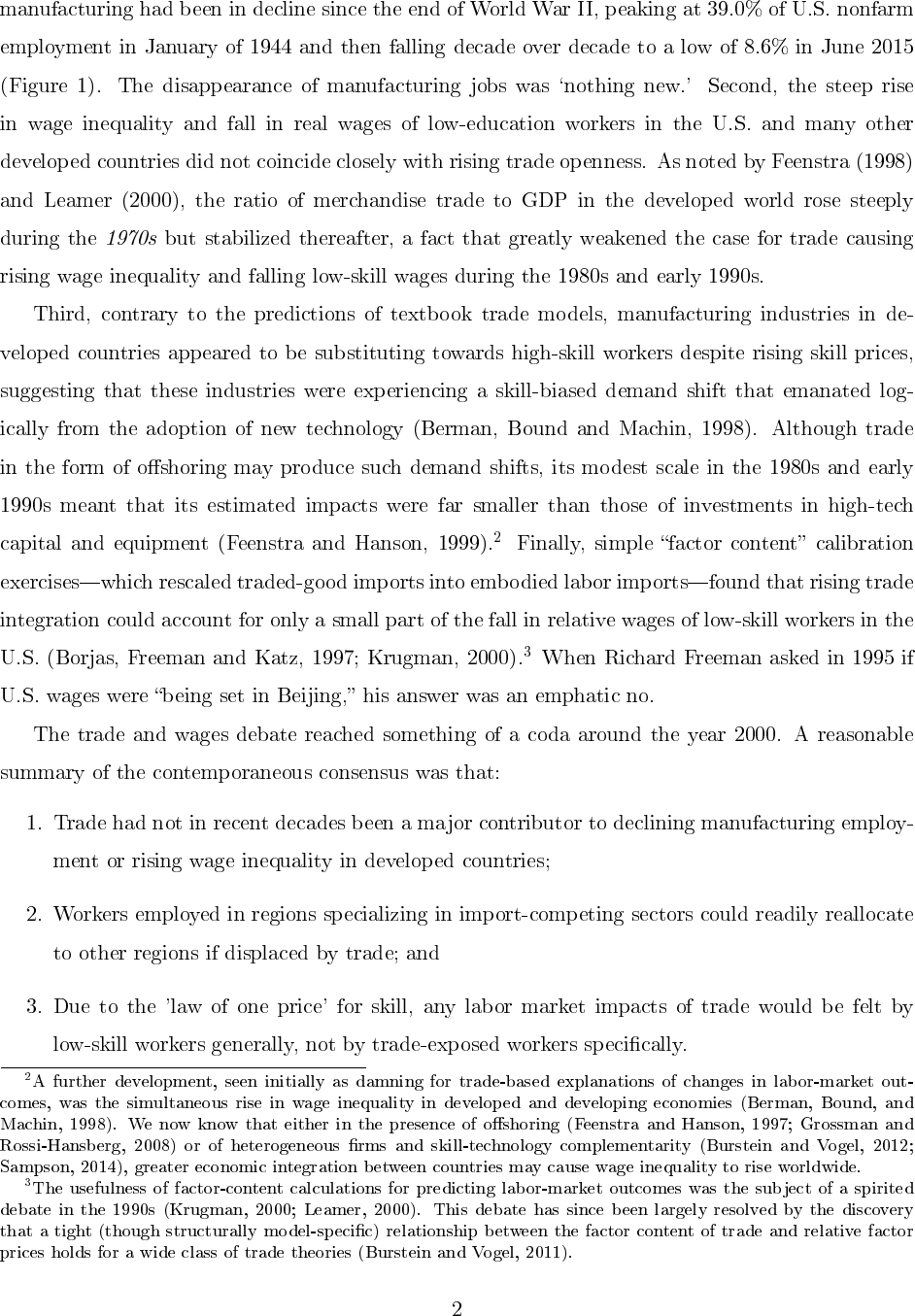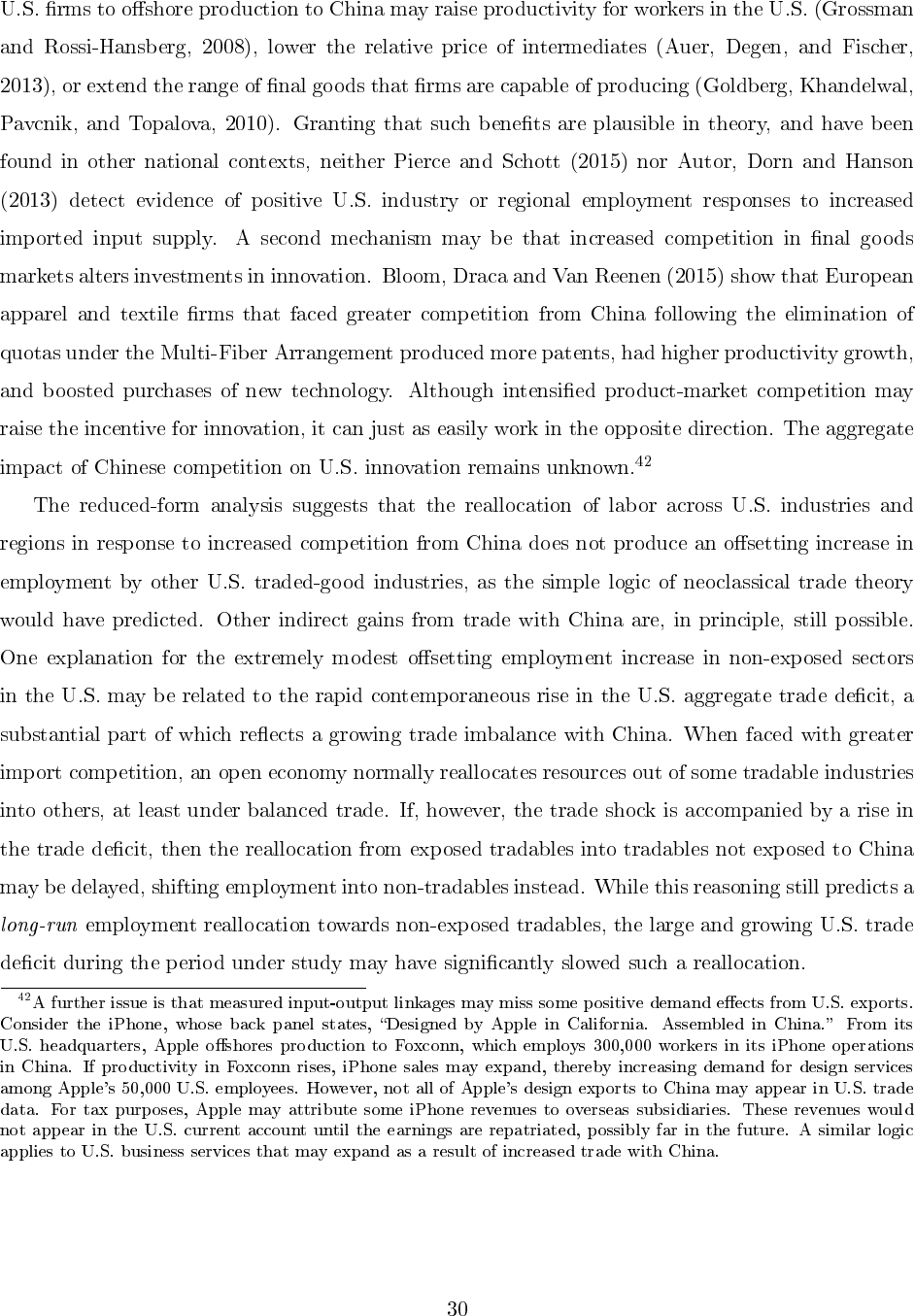NBER WORKING PAPER SERIES
THE CHINA SHOCK:
LEARNING FROM LABOR MARKET ADJUSTMENT TO LARGE CHANGES IN TRADE
David H. Autor
David Dorn
Gordon H. Hanson
Working Paper 21906
http://www.nber.org/papers/w21906
NATIONAL BUREAU OF ECONOMIC RESEARCH
1050 Massachusetts Avenue
Cambridge, MA 02138
January 2016
The views expressed herein are those of the authors and do not necessarily reflect the views of the
National Bureau of Economic Research.
NBER working papers are circulated for discussion and comment purposes. They have not been peer-
reviewed or been subject to the review by the NBER Board of Directors that accompanies official
NBER publications.
© 2016 by David H. Autor, David Dorn, and Gordon H. Hanson. All rights reserved. Short sections
of text, not to exceed two paragraphs, may be quoted without explicit permission provided that full
credit, including © notice, is given to the source.

The China Shock: Learning from Labor Market Adjustment to Large Changes in Trade
David H. Autor, David Dorn, and Gordon H. Hanson
NBER Working Paper No. 21906
January 2016
JEL No. F14,J23,J31
ABSTRACT
China’s emergence as a great economic power has induced an epochal shift in patterns of world trade.
Simultaneously, it has challenged much of the received empirical wisdom about how labor markets
adjust to trade shocks. Alongside the heralded consumer benefits of expanded trade are substantial
adjustment costs and distributional consequences. These impacts are most visible in the local labor
markets in which the industries exposed to foreign competition are concentrated. Adjustment in local
labor markets is remarkably slow, with wages and labor-force participation rates remaining depressed
and unemployment rates remaining elevated for at least a full decade after the China trade shock commences.
Exposed workers experience greater job churning and reduced lifetime income. At the national level,
employment has fallen in U.S. industries more exposed to import competition, as expected, but offsetting
employment gains in other industries have yet to materialize. Better understanding when and where
trade is costly, and how and why it may be beneficial, are key items on the research agenda for trade
and labor economists.
David H. Autor
Department of Economics, E17-216
MIT
77 Massachusetts Avenue
Cambridge, MA 02139
and NBER
David Dorn
University of Zurich
Department of Economics
Schoenberggasse 1
CH-8001 Zurich - Switzerland
Gordon H. Hanson
IR/PS 0519
University of California, San Diego
9500 Gilman Drive
La Jolla, CA 92093-0519
and NBER



0.04 0.08 0.12 0.16 0.20 0.24 0.28 0.32 0.36 0.40
Manufacturing Share of Non-Farm Employment
1939 1944 1949 1954 1959 1964 1969 1974 1979 1984 1989 1994 1999 2004 2009 2014


0
5
10
15
20
25
percent
1990 1995 2000 2005 2010
Year
China share of world manufacturing value added
China share of world manufacturing exports
Source: World Development Indicators.
China's share of world manufacturing activity



-10
-5
0
5
10
15
percent of GDP
1985 1990 1995 2000 2005 2010
Year
Net exports of manufacturing
Net exports of food, fuels, ores and metals
Source: World Development Indicators.
Exports minus imports as share of GDP for China
-1.5
-1
-.5
0
.5
log RCA
1988 1992 1996 2000 2004 2008 2012
Year
China RCA in manufacturing
China RCA in food, fuels, ores and metals
Source: World Development Indicators.
Revealed comparative advantage for China


∆
-20 0 20 40 60 80 100
Growth Net Import Penetr. 1991-2007
.2 .4 .6 .8 1
Share of Production Workers 1991
food/tobacco textile/apparel/leather
wood/furniture paper/print
chemical/petroleum plastic/rubber/glass
metal/metal products machines/electrical
transportation toys/other


-5
0
5
10
percent of GDP
1985 1990 1995 2000 2005 2010
Year
China current account balance
U.S. current account balance
Source: World Development Indicators.
Current account balance (percent of GDP)



i
X
i
=
X
k
A
ik
τ
−θ
ik
Φ
k
E
k
X
i
i A
ik
i k τ
ik
i
k θ E
k
i i

k Φ
k
k Φ
k
≡
P
i
0
A
i
0
k
τ
i
0
k
−θ
i
ˆx ≡ dx/x
i
ˆ
X
i
=
X
k
φ
ik
ˆ
E
k
− θ ˆw
i
+
X
k
φ
ik
ˆ
A
k
−
X
k
φ
ik
X
i
0
6=c
ρ
i
0
k
ˆ
A
i
0
k
−
X
k
φ
ik
ρ
ck
ˆ
A
ck
φ
ik
≡ X
ik
/X
i
k i ρ
ik
≡
X
ik
/E
k
i k c
ˆ
A
ik
=
ˆ
A
k
− θ ˆw
i
i
X
k
φ
ik
ρ
ck
ˆ
A
ck
=
X
k
φ
ik
"
X
ck
ˆ
A
ck
E
k
#
i
φ
ik
i
A
ik
k i k i
i k
k
ˆ
A
k
i ˆw
i

P
k
φ
ik
ˆ
E
k

United States Japan Germany Spain Australia
∆ Chinese Imports (Bil$)
303.8 108.1 64.3 23.2 21.5
No. Industries with Import Growth
385 368 371 377 378
Correlation w/ U.S.-China Imports
1.00 0.86 0.91 0.68 0.96
Finland Denmark New Zealand Switzerland
∆ Chinese Imports (Bil$)
234.7 5.7 4.7 3.8 3.3
No. Industries with Import Growth
383 356 362 379 343
Correlation w/ U.S.-China Imports
0.92 0.58 0.62 0.92 0.55
First stage regressions (using import penetration variables as in ADHS QJE)
Japan Germany Spain Australia
coeff 1.918 3.897 9.203 13.646
se 0.112 0.136 0.551 0.495
t-stat 17.075 28.674 16.705 27.550
8 Non-U.S. Finland Denmark New Zealand Switzerland
coeff 1.169 16.041 24.541 61.478 40.995
se 0.046 1.368 2.250 2.866 3.408
t-stat 25.281 11.725 10.907 21.450 12.028
Correlations of imports across 397 4-digit industries are weighted using 1991 industry employment from the NBER Manufacturing database.
8 Non-US
Countries
Table 1. Imports from China in the U.S. and Other Developed Economies 1991 - 2007 (in Billions of 2007$),
and their Correlations with U.S.-China Imports
θ ˆw
i
i
i
P
k
φ
ik
ˆ
A
k
i

P
k
φ
ik
P
i
0
6=c
ρ
i
0
k
ˆ
A
i
0
k


∆L
jτ
= α
τ
+ β
1
∆IP
jτ
+ γX
j0
+ e
jτ
.
∆L
jτ
j τ
∆IP
jτ
j τ β
1
X
j0
α
τ
e
jτ
∆IP
jτ
= ∆M
UC
j,τ
/ (Y
j,91
+ M
j,91
− E
j,91
) Y
j
M
j
E
j
∆M
UC
j,τ

1991-1999 1999-2011 1999-2007 2007-2011
Mean/SD Median Mean/SD Mean/SD Mean/SD Mean/SD
0.50 0.14 0.27 0.66 0.84 0.30
(0.94) (0.75) (1.33) (1.61) (1.68)
-2.71 -2.05 -0.30 -4.32 -3.62 -5.73
(3.07) (3.49) (3.85) (4.15) (5.02)
Based&on&AADHP&Tab&1.
Based&on&AADHP&Tab&1.
Table 2. Industry-Level Changes in Chinese Import Exposure and U.S. Manufacturing Employment.
Statistics are based on 392 4-digit manufacturing industries. The change in U.S. exposure to Chinese imports is computed by dividing 100 x the annualized
increase in the value of U.S. imports over the indicated period by 1991 U.S. market volume in that industry. Employment changes are computed in the
County Business Patterns. All observations are weighted by 1991 industry employment.
1991-2011
100 x Annual ∆ in U.S.
Exposure to Chinese Imports
100 x Annual Log ∆ in Emp.
(Manufacturing Industries)
1991-2007
(1) (2) (3)
-0.81*** -1.30*** -1.24***
(0.16) (0.41) (0.37)
1{1991-1999} -0.08 0.05 0.04
(0.36) (0.36) (0.36)
1{1999-2011} -3.79*** -3.46***
(0.33) (0.33)
1{1999-2007} -2.58***
(0.38)
Estimation Method OLS 2SLS 2SLS
Based&on&AADHP&Tab&2.
Table 3. Effect of Import Exposure on Log Employment Change in U.S.
Manufacturing Industries: OLS and 2SLS Estimates.
N = 784 (392 4-digit manufacturing industries x 2 periods 1991-1999 and 1999-2011 or 1999-2007).
Employment changes are computed in the County Business Patterns and are expressed as 100 x
annual log changes. Observations are weighted by 1991 employment. Standard errors in parentheses
are clustered on 135 3-digit industries. * p < 0.10, ** p < 0.05, *** p < 0.01.
Stacked First Differences
1991-2011
100 x Annual ∆ in U.S.
Exposure to Chinese Imports



(1) (2) (3) (4)
-0.60*** -0.18 0.22*** 0.55***
(0.10) (0.14) (0.06) (0.15)
(5) (6) (7) (8)
-0.05 -0.76*** -549.3*** 57.7***
(0.75) (0.25) (169.4) (18.4)
Based&on&ADH&Tab&5/6/8/9.
With an average annual wage of about $40k per employee, the employment loss by 0.78%pt lowers annual income by about $312 (0.0078*40000).
Table 4. Estimated Impact of a $1K per Worker Increase on Chinese Import Exposure on Outcomes in
U.S. Local Labor Markets, 1990-2007: 2SLS Estimates
N=1444 (722 commuting zones x 2 time periods 1990-2000 and 2000-2007). Employment, population and income data is
based on U.S. Census and American Community Survey data, while transfer payments are based on BEA Regional
Economic Accounts. All regressions control for the start of period percentage of employment in manufacturing, college-
educated population, foreign-born population, employment among women, employment in routine occupations, average
offshorability index of occupations, and Census division and time dummies. Models are weighted by start of period
commuting zone share of national population. Robust standard errors in parentheses are clustered on state. * p < 0.10, ** p
< 0.05, *** p < 0.01.
A. ∆ Fraction of Working Age Population in Manufacturing, Unemployment, NILF
B. ∆ Log Population, Log Wages, Annual Wage and Transfer Income
Employed in
Manufacturing
Employed in Non-
Manufacturing
Unemployed
Not in Labor Force
∆ Log CZ Population
(log pts)
∆ Avg Log Weekly
Wage (log pts)
∆ Annual Wage/Salary
Inc per Adult (US$)
∆ Transfers per Capita
(US$)
$1, 000
−0.60 −0.18
0.22 0.55

φ
ik
E
k





0.0078 × 40, 000
0.0076 × 0.7 × 40, 000

!"#$%&
!'#()&
!*)#))&
!*%#)(&
!*'#+,&
!%,#,"&
!)&
!*)&
!+)&
!")&
!()&
!%)&
!$)&
!,)&
-./012340/.5&
6.7&899&:/./;5<&
==9&>?<6@?2?54&
:/./;5<&
==9&A/BC/0/.5&
:/./;5<&
D5E/C&F3G/C.0/.5&
H.I30/&9<<?<56.I/&
F3G5&J/7?I62&
:/./;5<&
83562&:/./;5<&
>3226C&KE6.L/&&
H013C5<&MC30&KE?.6&6.7&KE6.L/&3M&F3G/C.0/.5&8C6.<M/C&A/I/?15<&?.&
K300NB.L&O3./<&P*QQ)R+)),S&&
&
Effect&of&an&$1000&Per&Worker&Increase&in&Imports&from&China&during&
1990=2007&on&Dollar&Change&of&Annual&Transfer&Receipts&per&Capita&


1
1.0

0.43
0.17
60
0 .2 .4 .6 .8 1 1.2
Coefficient
1991
1992
1993
1994
1995
1996
1997
1998
1999
2000
2001
2002
2003
2004
2005
2006
2007
Conditional correlation in trade exposure between 1991 firm and firm in indicated year
Counterfactual with zero trade exposure in all firms except 1991 firm
2 × 16
0









